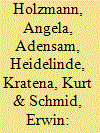|
|
|
Sort Order |
|
|
|
Items / Page
|
|
|
|
|
|
|
| Srl | Item |
| 1 |
ID:
117331


|
|
|
|
|
| Publication |
2013.
|
| Summary/Abstract |
In the European Union, electricity production from wind energy is projected to increase by approximately 16% until 2020. The Austrian energy plan aims at increasing the currently installed wind power capacity from approximately 1 GW to 3 GW until 2020 including an additional capacity of 700 MW until 2015. The aim of this analysis is to assess economically viable wind turbine sites under current feed-in tariffs considering constraints imposed by infrastructure, the natural environment and ecological preservation zones in Austria. We analyze whether the policy target of installing an additional wind power capacity of 700 MW until 2015 is attainable under current legislation and developed a GIS based decision system for wind turbine site selection.Results show that the current feed-in tariff of 9.7 ct kW h-1 may trigger an additional installation of 3544 MW. The current feed-in tariff can therefore be considered too high as wind power deployment would exceed the target by far. Our results indicate that the targets may be attained more cost-effectively by applying a lower feed-in tariff of 9.1 ct kW h-1. Thus, windfall profits at favorable sites and deadweight losses of policy intervention can be minimized while still guaranteeing the deployment of additional wind power capacities.
|
|
|
|
|
|
|
|
|
|
|
|
|
|
|
|
| 2 |
ID:
105746


|
|
|
|
|
| Publication |
2011.
|
| Summary/Abstract |
Climate change mitigation and security of energy supply are important targets of Austrian energy policy. Bioenergy production based on resources from agriculture and forestry is an important option for attaining these targets. To increase the share of bioenergy in the energy supply, supporting policy instruments are necessary. The cost-effectiveness of these instruments in attaining policy targets depends on the availability of bioenergy technologies. Advanced technologies such as second-generation biofuels, biomass gasification for power production, and bioenergy with carbon capture and storage (BECCS) will likely change the performance of policy instruments. This article assesses the cost-effectiveness of energy policy instruments, considering new bioenergy technologies for the year 2030, with respect to greenhouse gas emission (GHG) reduction and fossil fuel substitution. Instruments that directly subsidize bioenergy are compared with instruments that aim at reducing GHG emissions. A spatially explicit modeling approach is used to account for biomass supply and energy distribution costs in Austria. Results indicate that a carbon tax performs cost-effectively with respect to both policy targets if BECCS is not available. However, the availability of BECCS creates a trade-off between GHG emission reduction and fossil fuel substitution. Biofuel blending obligations are costly in terms of attaining the policy targets.
|
|
|
|
|
|
|
|
|
|
|
|
|
|
|
|
| 3 |
ID:
125751


|
|
|
|
|
| Publication |
2013.
|
| Summary/Abstract |
In Austria a considerable number of measures have been implemented to reduce final energy use for residential heating since the 1990s. The aim of this analysis is to investigate, why - despite these implemented measures - final energy use for heating has not decreased in the expected way. The impact of eight factors on final energy use for heating is quantified by applying the Logarithmic Mean Divisia Index (LMDI I) method. The dataset covers the sector of private households in Austria for the period from 1993 to 2009. The main findings of the analysis are: (1) while technical improvements reduce final energy use for heating significantly, rising comfort needs nearly outweigh these savings. (2) Consumer behaviour reduces calculated final energy use considerably. (3) The extent of this reduction is declining significantly in the period observed. (4) The growing share of single-family houses has increased energy demand for heating in the observed period, though a reversal of this trend is detected from 2007 onwards. (5) The impact of growing floor space per person is the major effect revealed by the analysis. (6) Weather conditions have a major impact on annual fluctuations of energy consumption.
|
|
|
|
|
|
|
|
|
|
|
|
|
|
|
|
| 4 |
ID:
109599


|
|
|
|
|
| Publication |
2011.
|
| Summary/Abstract |
Recently, an active debate has emerged around greenhouse gas emissions due to indirect land use change (iLUC) of expanding agricultural areas dedicated to biofuel production. In this paper we provide a detailed analysis of the iLUC effect, and further address the issues of deforestation, irrigation water use, and crop price increases due to expanding biofuel acreage. We use GLOBIOM - an economic partial equilibrium model of the global forest, agriculture, and biomass sectors with a bottom-up representation of agricultural and forestry management practices. The results indicate that second generation biofuel production fed by wood from sustainably managed existing forests would lead to a negative iLUC factor, meaning that overall emissions are 27% lower compared to the "No biofuel" scenario by 2030. The iLUC factor of first generation biofuels global expansion is generally positive, requiring some 25 years to be paid back by the GHG savings from the substitution of biofuels for conventional fuels. Second generation biofuels perform better also with respect to the other investigated criteria; on the condition that they are not sourced from dedicated plantations directly competing for agricultural land. If so, then efficient first generation systems are preferable. Since no clear technology champion for all situations exists, we would recommend targeting policy instruments directly at the positive and negative effects of biofuel production rather than at the production itself.
|
|
|
|
|
|
|
|
|
|
|
|
|
|
|
|
| 5 |
ID:
132689


|
|
|
|
|
| Publication |
2014.
|
| Summary/Abstract |
Photovoltaic (PV) has developed to one of the most promising technologies for renewable electricity generation. The Austrian government currently provides subsidies for roof-top PV systems through a constant, administratively determined feed-in tariff or an investment co-funding. In both subsidy schemes, applications are approved on a first-come, first-served basis. There are concerns about (i) the selection of suitable roofs for PV systems, and (ii) allocating subsidies among applicants to deploy roof-top PV systems cost-effectively. Thus we analyze the potentials of a simple discriminative first-price reverse auction application scheme. Applicants define individually the required level of subsidy and those with the lowest request for subsidies are selected. In an ex-post analysis, we evaluate the potentials of such a scheme in increasing power output and saving public spending for the federal state of Vorarlberg in Austria. Results indicate a potential increase of cumulated produced electricity between 15% and 18% in comparison to the current policy. In addition, a reverse auction-based system would lead to savings of public spending per kWh between 20% and 41%.
|
|
|
|
|
|
|
|
|
|
|
|
|
|
|
|
|
|
|
|
|